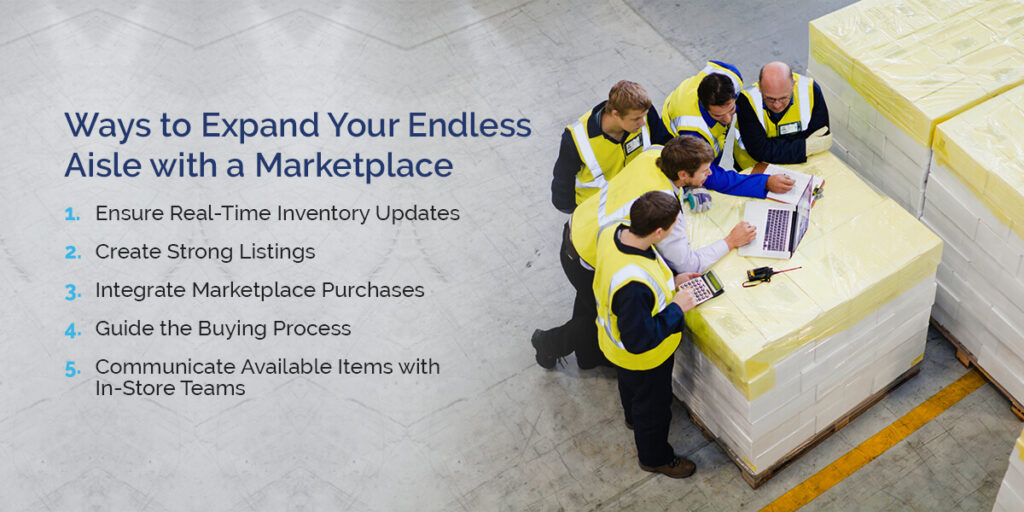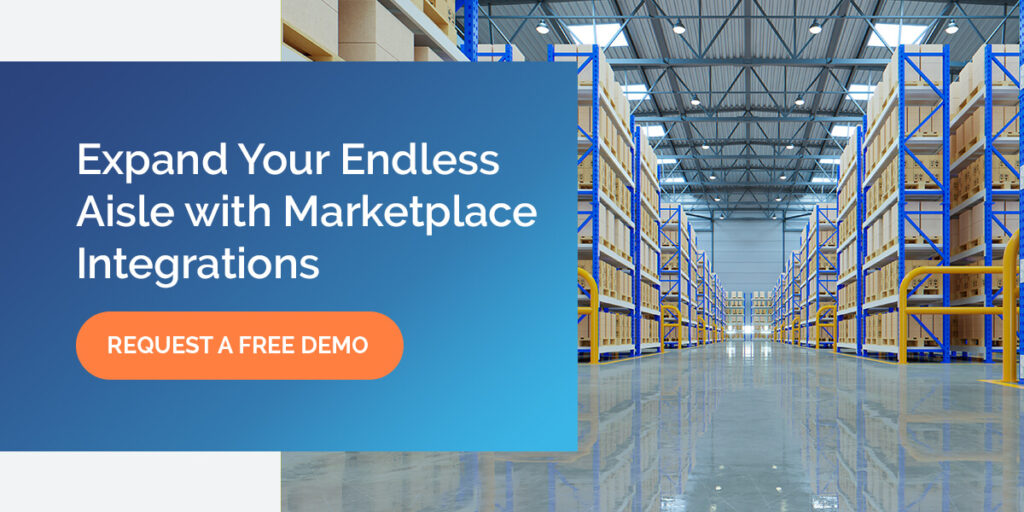How to Expand Your Endless Aisle

October 11, 2023
The endless aisle model can help you bridge the gap between online and in-store shopping, but if you want to make the most of it, you’ll need to offer as many options as possible in a connected environment. Today’s omnichannel shopping environment gives customers a seemingly unlimited selection, so a robust endless aisle can help you keep customers in your ecosystem.
It’s a fast-growing solution with significant potential. Mirakl’s marketplace platform, for example, saw sales increase by 53% year over year during Cyber Week 2022 — far ahead of the 2% overall growth of eCommerce. Many marketplaces offer endless aisle expansion without asking you to increase your inventory or take on extra work to acquire the items, and they’re an excellent way to expand your catalog.
The Link Between Marketplaces and Endless Aisles
Marketplaces allow you to list products from third-party sellers on your website or your endless aisle platform. Generally, the seller will ship the item directly to the customer — or to your physical store, if you offer that service — leaving you to take a commission and improve the customer experience without increasing fulfillment demands. Customers appreciate marketplaces, too, with 77% of shoppers naming them the most convenient way to shop.
Adding marketplace items to your endless aisle allows customers to browse a much larger selection of products in your store. If they don’t see something they like in your catalog, they can still make a purchase through your brand without leaving the store.
Some of the benefits associated with marketplaces for endless aisles include the following:
- Improved retention: More options can prevent customers from going to the competition. They continue to buy from your brand and get the experience that comes along with it. You could even offer perks to solidify a positive experience, such as using loyalty points or keeping their purchases on file.
- Hands-on shopping and sales support: One of the biggest benefits of an endless aisle is the ability to see a product in-store before buying it. While you may not carry these third-party items in-store, your staff can answer questions and show customers similar items that could be representative of the marketplace product. Say a customer is interested in a waterproof Bluetooth speaker, but you only have a non-waterproof version in-store. They can still get a similar experience before buying the waterproof option from a third party.
- Cross-selling and upselling opportunities: In-store shopping provides opportunities for interacting with your support staff. Customers can ask questions and chat with representatives, who can then promote additional products or services. Salespeople also have a larger catalog of items to suggest, improving their ability to suggest effective products.
- Fewer lost sales: A marketplace can offer alternatives if you don’t carry or run out of a certain product. It allows you to provide a better experience for customers and keep sales in the store.
- Convenient shipping and return options: Many customers shop in-store to avoid shipping costs or potential damage during transit. You can use a marketplace to offer better fulfillment options, like free ship-to-store or ship-to-home service. You could also provide in-store returns for marketplace items to simplify the process further.
With various benefits for customers and brands, marketplaces and endless aisles make a great pair.

Ways to Expand Your Endless Aisle with a Marketplace
Adding a marketplace isn’t as simple as adding third-party products to your website. For optimal results, you must integrate it well with your endless aisle strategy for a cohesive, seamless experience. Try the following techniques for a successful expansion:
1. Ensure Real-Time Inventory Updates
Working with third-party sellers means sharing up-to-date information on stock levels. You need to know how much stock they have, and they need to know when you make a sale. Without this information-sharing, customers could run into canceled orders and negative experiences, and you must spend resources fixing the problem. These issues can be time-consuming and costly, and reputational damage is particularly hard to fix.
Before implementing a marketplace, ensure you can share inventory values immediately with your third-party sellers. Look for reliable integrations and set up a quick onboarding procedure so you can adjust your marketplace as needed.
2. Create Strong Listings
Since you may not have marketplace items in-store, customers need descriptive, informative product details. You could set up requirements for your partners or create listings yourself, but they should offer compelling images, product specifications, and other information customers may need to make a purchase. Inadequate listings can reflect poorly on your brand, making shoppers think your website doesn’t provide a good browsing experience.
3. Integrate Marketplace Purchases
Make sure the experience of buying marketplace items feels cohesive with the rest of your brand. For example, marketplace purchases can show up in the customer’s order history if you offer loyalty accounts. Like regular purchases, marketplace purchases can benefit from fulfillment and tracking updates. Provide the same checkout process your buyers expect.
Make them feel confident buying from a trusted brand rather than one they don’t know. A customer could be much more likely to make a third-party purchase if they know they can return the item for free by visiting your store like they would with something bought from your brand.
4. Guide the Buying Process
An endless aisle device, such as a kiosk, can be unfamiliar to some buyers. Walk them through the process with prompts and instructions. Make it clear when they buy a marketplace item rather than one of your products so no one gets misled. Although they pay the store, the item comes from a third-party seller, so a simple disclaimer can help prevent misunderstandings.
Another way to help the buyer is to offer recommended products. You can facilitate additional sales with a more extensive catalog and a strong recommendation engine.
5. Communicate Available Items with In-Store Teams
If in-person employees don’t know what’s on the marketplace, they can’t offer those solutions to customers. Instead of saying you don’t have something, workers can help customers find a solution in-store without going to a competitor.
Consider the endless aisle solution when developing sales strategies, such as upselling accessories or related products. By encouraging its use, you can make the process feel seamless and keep customers connected to your brand.

Expand Your Endless Aisle with Marketplace Integrations
A larger endless aisle experience can maximize the benefits of this approach, and marketplaces help you expand without complicated inventory requirements. If you’re focused on retention or the customer experience, a robust marketplace and endless aisle solution can offer significant advantages.
When expanding your endless aisle, your integration and marketplace platforms are crucial. TrueCommerce now integrates with Mirakl, combining our seamless electronic data interchange (EDI) solution with a leading marketplace platform. Reach out today to learn how we can support streamlined information-sharing for your endless aisles.
Share this post:
Stay ahead of the competition
Get expert supply chain insights delivered directly to your inbox weekly.